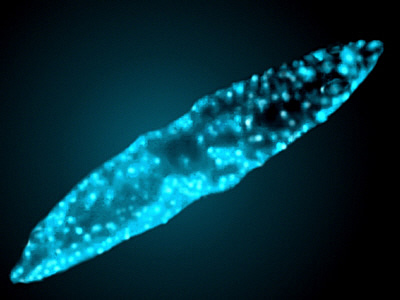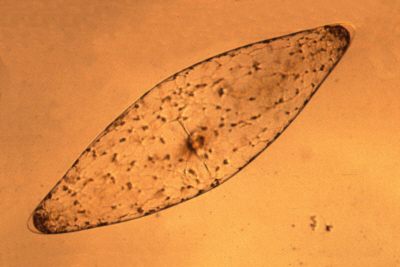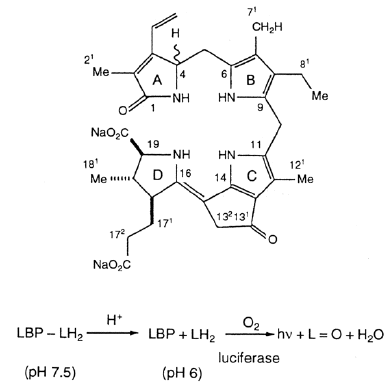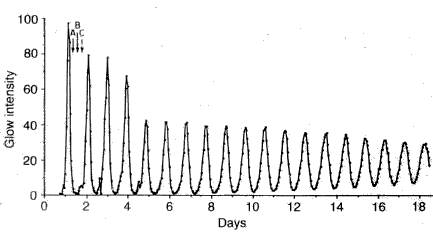Bioluminescence in Dinoflagellates
Biology 342 Fall 2010
Caitlin Miller and Madeline Dansky
Mechanism
Mechanism is a description of the structure of an organism and how it works (18)
Luminescent Waves: bioluminescent dinoflagellates illuminating ocean waters

image courtesy: Wikipedia Commons (12)
Mechanical Stimulus and Bioluminescence
Bioluminescent behavior of dinoflagellates occurs most often in the epipelagic zone – the top layer – of the ocean (22). Dinoflagellate bioluminescence is primarily considered to be a stress response. It is a mechanical response to a change in their environment, such as the flow of water. Because dinoflagellates luminate in the presence of motion, it has been hypothesized as an anti-predatory mechanism. The mechanism by which this process takes place is called mechanotransduction. Mechanotransduction involves G-proteins, and ultimately results in a mechanical stimulus being turned into a chemical one (23). The minimum response threshold for dinoflagellates is dependent upon the species, and ranges from 0.02 to 0.2 N m-2. (26).
Shear Stress and Light Emission
It has been found that both the intensity and decay rate of bioluminescence are related to shear stress. Shear stress indicates that the dinoflagellate responds to the direct force acting upon the cell. Bioluminescence increases with an acceleration of stimuli. The emission of light begins to decrease if the stimulus is constant (26). A dinoflagellate emits light in the presence of a fluid force that comparable to the change in its environment that would occur if a predator approached.
Pyrocystis fusiformis, light is emitted from specialized organelles called scintillons (14), as can be observed in the images below by the discrete circular bodies that are glowing within the cells.


image courtesy: Edith A. Widder, Harbor Branch Oceanographic Institution (14)
Change in pH Level and the Chemical Production of Light
Dinoflagellates flash bright blue in response to a mechanical stimulus, which can be as small as an air bubble popping. The mechanism for this emittence of light is performed through the lowering of pH level, from 8 to 5.7 (see Figures 1,2 below). It is an exergonic chemical reaction involving oxygen and the substrates present in the dinoflagellate. Subcellular particles, called scintillons, are affected by this pH change.
 Scintillons are specialized organelles that contain the three molecules necessary for the production of light: dinoflagellate luciferase (figure 3), its luciferin substrate (figure 2) and a luciferin-binding protein (16). The substrate luciferin (believed to have been derived from chlorophyll) is responsible for the pH change. The enzyme luciferase catalyzes the reaction. Luciferin must be present in excess inside the cell for the scintillon to emit light, which must take place at a pH of 5.7. In order to reemit, the scintillion must be recharged at a pH of 8 (25). A change in the amino acid sequence of the luciferase enzyme often can change the color of the luminescence (28). For example, Dinoflagellate luminescence is blue, since this wavelength travels best in water (27).
Scintillons are specialized organelles that contain the three molecules necessary for the production of light: dinoflagellate luciferase (figure 3), its luciferin substrate (figure 2) and a luciferin-binding protein (16). The substrate luciferin (believed to have been derived from chlorophyll) is responsible for the pH change. The enzyme luciferase catalyzes the reaction. Luciferin must be present in excess inside the cell for the scintillon to emit light, which must take place at a pH of 5.7. In order to reemit, the scintillion must be recharged at a pH of 8 (25). A change in the amino acid sequence of the luciferase enzyme often can change the color of the luminescence (28). For example, Dinoflagellate luminescence is blue, since this wavelength travels best in water (27).
Figure 1. Activation of Lingulodinium bioluminescence upon a shift from pH 8 to 6 showing that luciferase changes from an inactive to active form while luciferin binding protein (LBP) releases bound luciferin.
image (above) and figure legend courtesy of: Hastings, J. Woodland, Wayne Schultz, and Liyun Liu (15)
LIGHT EMISSION REACTION COMPONENTS: Luciferin, Luciferase, Luciferin-Binding Protein

Figure 2. Dinoflagellate luciferin, dLH2, a reduced tetrapyrrole, isolated from Pyrocystis lunula.
image and figure legend courtesy of: Hastings, J. Woodland, Wayne Schultz, and Liyun Liu (15)

Figure 3. Structure of dinoflagellate luciferase with its three intramolecular homologous domains and N-terminal region.
image and figure legend courtesy of: Hastings, J. Woodland, Wayne Schultz, and Liyun Liu (15)
Dinoflagellates Only Luminate at Night: Circadian Clock
Several bioluminescent dinoflagellates have been shown to have patterns of regulated light emissions, emitting light only at night and not during the daytime. The light-emitting species Lingulodinium polyedrum is one example of a dinoflagellate controlled by a regular cellular circadian rhythm, commonly called a biological “clock” (16). The bioluminescent emissions are more commonly produced as a result of mechanical stimulus during the night than during the day (16). Like most circadian processes, the period of luminescent emission is only roughly 24 hours long and is not perfectly exact (16). Cultures performed by J. Woodland Hastings, Wayne Schultz, and Liyun Liu’s research, which were maintained under constant temperature and light conditions, showed the same rhythmic luminescence for several weeks (16). Indicating the mechanisms and expression of light-production is controlled by a biological clock.
Daily Circadian Rhythm in Lingulodinium
A circadian clock in Lingulodinium polyedrum has be shown to occur on a daily basis, and to regulate the mechanism of light-emission on at the level of gene expression (16). These daily changes can be observed in fluctuating concentrations of the three components of the light-producing reactions: luciferase, luciferin and luciferin-binding protein (LBP) (16). All of these proteins are created daily. It has even been shown that the specialized organelles called scintillons, are formed constructed and destroyed over the circadian cycle (16). Research on this gene expression has shown that mRNA levels of LBP and luciferase are constant over the circadian cycle, which indicates that the biological regulation does  not take place at the transcription level but at the translation level (16).
not take place at the transcription level but at the translation level (16).
Left Figure. Persistent circadian rhythm of bioluminescence in a Lingulodinium culture maintained for 20 days in constant dim light. Other processes (A, B, C) also exhibit rhythms with maxima at different times of day, as indicated by arrows.
image and figure legend courtesy of: Hastings, J. Woodland, Wayne Schultz, and Liyun Liu (15)